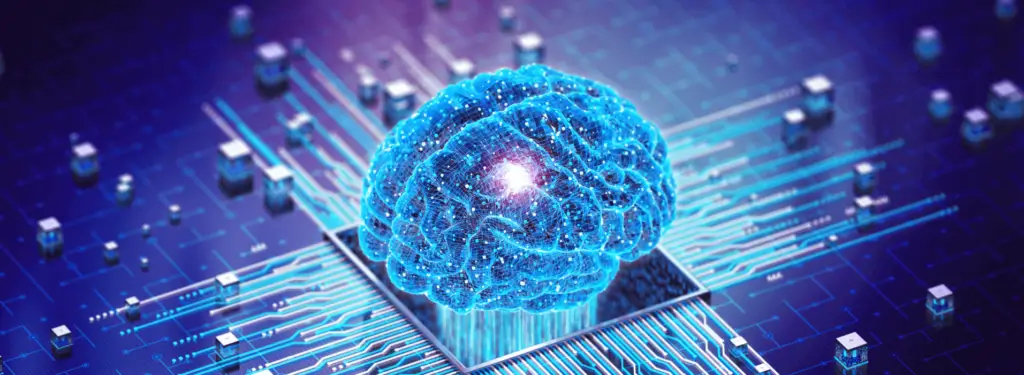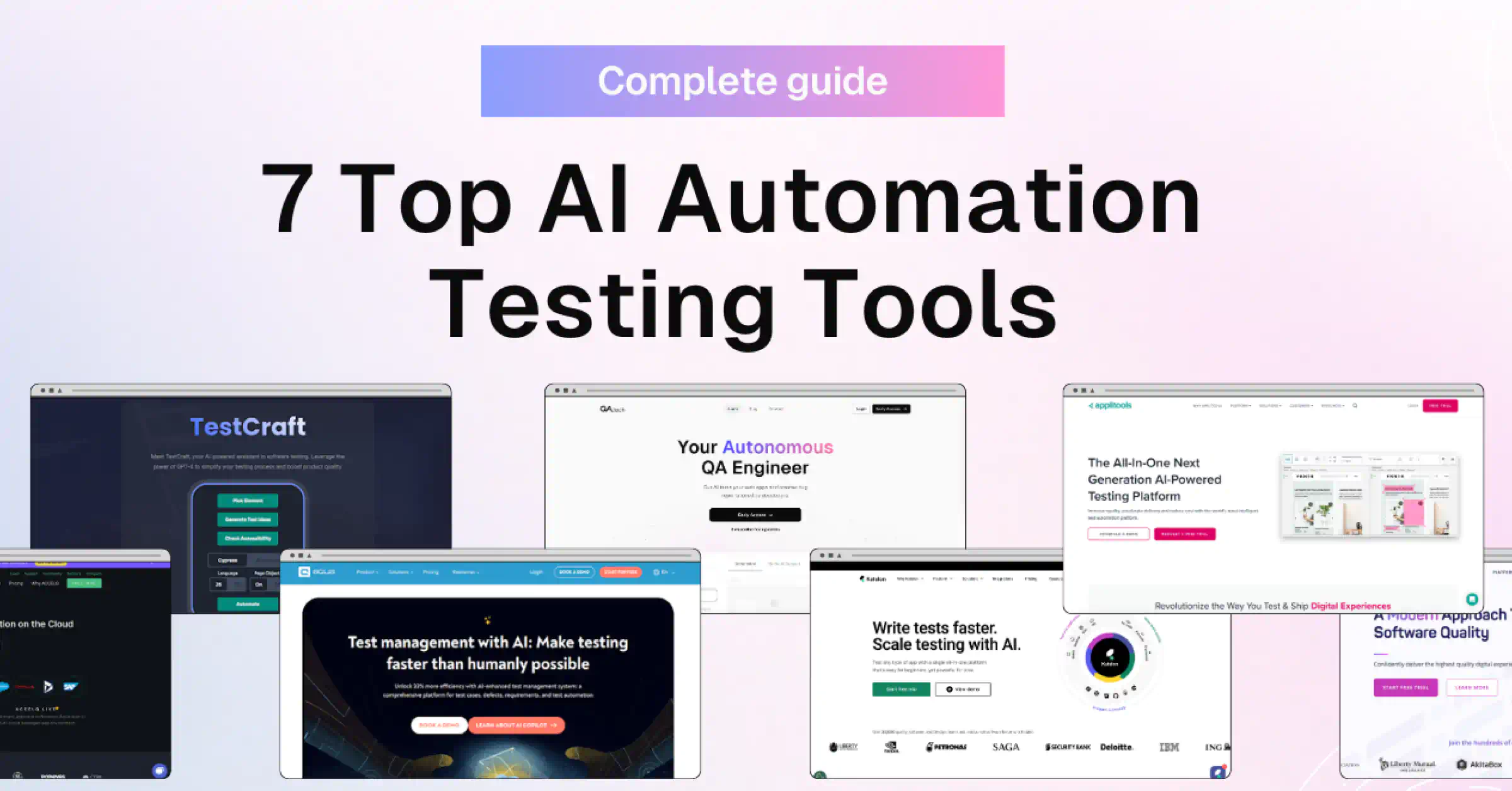Artificial Intelligence (AI) has had a significant impact on software testing. With app requirements becoming more complex, companies have to rely on AI to get high-quality software out quickly.
Product teams now use machine learning in test automation to speed up software development life cycles (SDLC). Natural language processing (NLP) algorithms can help testers analyze bug reports, and predictive analytics can foresee potential performance issues and risks.
This article discusses the changes AI has brought to the industry and how AI in quality assurance can help product teams make their software launches even more successful.
By the end, you’ll learn how AI can facilitate your software development life cycles and how to integrate it into your current frameworks.
What Is AI in Software Testing?
AI in software testing involves the use of artificial intelligence (AI) algorithms to automate and refine different stages of software testing. With this approach, you leverage AI capabilities such as machine learning, natural language processing, and predictive analytics to generate test cases, prioritize testing efforts, predict defects, and interpret test results.
AI in software testing analyses large volumes of historical testing data and system outputs. AI uses this information to uncover patterns, deviations from the norm, and potential trouble spots.
Through this analysis, AI can help automate routine testing tasks and reduce manual effort. QA teams can broaden test coverage and deliver high-quality software products to market faster than ever.
Is AI for Test Automation Essential?
AI-powered software testing has become indispensable for handling intricate testing challenges. This is especially true for complex software applications that involve large volumes of data and evolve rapidly.
AI excels in automating tests in environments with extensive testing needs, intricate system interactions, and requirements for predictive insights. Industries like finance, healthcare, and e-commerce, where software reliability and security are critical, can significantly benefit from AI-powered test automation. AI’s importance extends to situations where conventional rule-based automation falls short in handling applications’ complex and evolving nature.
For instance, in B2B web applications and SaaS platforms with evolving features and user workflows, AI-powered test automation can adapt seamlessly. It can analyze user behavior patterns, identify changes in application functionalities, and leverage this data to automatically adjust test cases. This ensures comprehensive test coverage and a consistently reliable user experience for businesses.
Conversely, the need for AI in test automation may not be as crucial when dealing with straightforward software systems with a stable architecture, well-defined functionality, and limited data complexity. Traditional test automation methods might be sufficient in situations where user interactions are predictable and the application’s behavior doesn’t change frequently.
Consider static reporting applications where data inputs and outputs follow consistent patterns because software testing AI is not necessary for building such software.
How Is Artificial Intelligence and Software Testing Changing Product Development?
AI in software testing has transformed product development in the following ways:
1. Predictive Insights
AI improves software testing with predictive analytics. This technology uses machine learning and deep learning algorithms to learn from past data and predict future outcomes. If product teams can identify potential issues before they happen, they can correct them early enough and minimize the chances of major defects slipping into the final product.
2. Adaptive Testing
AI analyzes user behavior, identifies application changes, and uses these insights to suggest potential test case adaptations. This ability to adapt allows product teams to adjust test scenarios and strategies, make informed decisions, and react swiftly.
For instance, it can identify areas where the code has been modified and generate tailored test scenarios for those changes. This innovative approach guarantees thorough testing by covering all relevant code areas. It also reduces the need for manual test case creation.
3. Realistic User Behavior Simulation
AI can simulate realistic user behaviors and load patterns. It begins with collecting data from user interactions, such as navigating the app interface and clicking buttons. AI models are then trained on this data to imitate the actions of real users within the testing environment.
This capability ensures that products are tested under conditions resembling real-world usage. This way, product teams can guarantee more accurate performance and usability testing.
4. Autonomous Testing
Thanks to AI in software test automation, product teams can now run comprehensive test cases faster than ever. Autonomous testing uses artificial intelligence (AI) and machine learning (ML) techniques to design, execute, and analyze tests without requiring continuous human intervention.
Developers can execute tests faster and more efficiently using AI for test automation than traditional methods.
Why Should You Integrate AI in Software Test Automation?
Integrating AI in software testing can streamline your testing process and improve software quality in the following ways:
5. Accelerate Timelines
AI-powered test automation can significantly speed up testing by automating test case generation, execution, and result analysis. This acceleration leads to shorter development cycles and faster time-to-market for software products.
6. Faster Iterations
AI quickly identifies and resolves defects. Allowing for faster iterations and continuous improvement of the software. Rapid feedback loops facilitated by AI-driven testing contribute to more agile and responsive development processes.
7. Prioritize Testing Efforts
With AI, product teams can rapidly go through the cycle of making changes to the software, testing those changes, and leaving feedback. This capability ensures that testing resources are directed to the most impactful areas.
8. Clarity on Client Requirements
Software testers can analyze and extract insights from client requirements through natural language processing (NLP) and machine learning techniques. These technologies can understand the semantic meaning of client requirements and feedback.
9. Test for Security
AI-powered testing tools can recreate complex security threats, allowing testers to conduct thorough security checks. This proactive approach helps detect and fix security concerns early in the development process. Otherwise, the finished product would have several weak spots.
10. Scale Efficiently
Using AI for test automation gives the advantage of scaling to handle large and complex testing scenarios. This approach can accommodate diverse environments, user behaviors, and data sets. This way, testing remains effective and efficient, even as software systems become more complex.
Is AI Software Testing Better than Manual Software Testing?
Using AI for software testing offers several advantages over manual testing, particularly in efficiency, scalability, and repeatability. AI automates test generation and execution, allowing product teams to conduct faster and more thorough testing. Moreover, it can handle large volumes of test data and execute multiple test scenarios simultaneously.
Using traditional testing methods alone, you’ll have to hire so many software testers that the cost of maintaining a large testing team becomes unsustainable, eating into the project’s budget. If using AI for software testing is so great, will AI-driven testing assurance replace human testers?
The simple answer is no. At least, not yet. AI testing has limitations when it comes to tasks that need a human touch. It’s neither creative nor possesses enough domain experience to be fully autonomous. AI algorithms may be unable to completely evaluate user experience and how easy app features are to use. These are areas where you need human testers.
Unlike automated tests, manual testing allows testers to perform unscheduled and spontaneous testing. They can rely on their real-world experience to identify potential problems that may have gone unnoticed.
Additionally, manual testers bring domain-specific knowledge and context to the testing process. This allows them to evaluate the software functionality from both a business and consumer perspective.
Manual Software Testing vs. AI Software Testing Capabilities
Here’s a glance at the strengths and weaknesses of both testing methods:
| Manual Software Testing | AI Software Testing |
| Time-consuming and resource-intensive | Saves time and enables faster product delivery |
| Able to handle complex and nuanced test scenarios | Less suitable for handling sophisticated testing |
| Tests are performed linearly and sequentially | Accelerates test execution speed through automation |
| Ideal for UX and exploratory testing | It may not be feasible for complex human-centric tests |
| Requires active involvement of human testers | Involves minimal human intervention in executing test cases |
| Limited test coverage due to manual limitations | High test coverage, capable of executing a large number of tests in a short time |
| Costly due to hiring and training manual testers | Requires initial investment in AI tools and training, but highly cost-effective in the long run |
Benefits of AI-Powered Software Testing
AI software testing makes product development better in the following ways:
1. Enhanced Test Efficiency
AI testing tools simplify and expedite testing by automating test case creation, execution, and maintenance. The automated approach frees up testers to focus on high-priority activities, reducing testing time and accelerating software development.
2. Higher Testing Accuracy
AI can analyze vast amounts of testing data to identify patterns, predict potential defects, and prioritize testing efforts. Its wealth of data makes it efficient in detecting defects and identifying key areas that need more testing attention. This comprehensive approach ultimately elevates the quality of the end product.
3. Improved Test Coverage
Combining artificial intelligence and software testing can improve test coverage by executing a vast number of test cases across diverse scenarios and configurations. Expanding AI testing to cover various scenarios strengthens the software’s dependability and resilience.
4. High-Quality Software
AI-driven automated tests reduce the risk of human errors because they are executed with precision and accuracy. Intelligent bug detection helps testers uncover defects early and fix them. With a streamlined approach to testing, product teams can quickly deliver software with fewer defects, improved reliability, and better overall performance.
5. Faster Time-to-Market
Getting an application launched quickly in today’s market conditions is highly important. A slow time-to-market can distract us from the revenue, and the competitors go earlier.
However, careful analysis is also indispensable, but it can be time-consuming. This will be done by AI by automating routine uses and testing it simultaneously on many devices.
Essentially, this process will give you the freedom to do other important things, and you will find bugs earlier. Ultimately, AI is an important means of delivering high-quality software at a faster speed.
How to Leverage AI and Machine Learning in Test Automation
Combining AI and software testing can be exciting. Here are the key steps to harness the power of AI in your software testing process:
1. Identify Test Scenarios and Use Cases
Before introducing new AI-driven tools in your software testing systems, you must understand what test processes you need to automate. Collaborate with your testing teams and domain experts to thoroughly assess your testing requirements. You’ll find repetitive, data-intensive, or complex test cases that can benefit from the capabilities of these technologies.
Group these test cases based on their complexity, execution frequency, data-intensive tasks, and scenarios prone to human error. This grouping will help you optimize resources by directing AI towards areas where they can deliver the most value.
2. Review AI and ML Tools
With several AI automation tools in the market, you’ll have to scrutinize your options to find a platform that aligns with your project requirements. The right AI and ML platform should handle most of your testing objectives and technical requirements.
Search the internet for top AI automation testing tools. Amongst many options, filter your prospects by considering how easy it is to use each tool. If your product team is unfamiliar with complex testing solutions, they may be unable to adapt quickly. You also want to assess the compatibility of these tools to see if they can integrate with your existing test frameworks.
QA.Tech is one of the best AI-powered testing tools out there. It has a smooth interface, and remarkable autonomous testing features will save you lots of time and money.
3. Integrate AI into your Test Automation Framework
This final step involves using APIs, SDKs, or custom integrations to link your chosen AI tools with the testing infrastructure. After integration is complete, you can start designing test scenarios and executing them automatically. AI testing platforms like QA. Tech provides reporting features to help you track metrics and improve.
What AI Can Do in Software Testing
AI’s applications in software testing include:
- Generate test cases
- Predict defects
- Detect anomalies
- Intelligent test prioritization
- Log analysis and root cause identification
What AI Can’t Do in Software Test Automation
Here are critical aspects of software testing that AI can’t handle:
- Human judgment and creativity
- User experience testing
- Interpreting unclear software requirements
- Contextual understanding and domain knowledge
- Ethical and regulatory compliance testing
Tips for Implementing AI in Software Testing
Here are some best practices to maximize software testing and AI:
1. Learn About AI/ML Systems and Your Testing Workflows
While implementing AI in software testing, learn everything about AI and machine learning (ML) systems. Find out how they work, their strengths, limitations, and potential unexplored applications. At the same time, you need to have your current testing workflows at your fingertips. Understanding your testing framework allows you to identify specific areas where AI can be helpful.
2. Be Patient
Implementing AI in software testing requires patience, often involving a learning curve and iterative refinement. Remember that the initial stages of integrating AI into your testing infrastructure may make you somewhat clueless. Be patient and allow the AI systems to learn and adapt to the nuances of your software testing process.
3. Learn Prompt Engineering
Prompt engineering involves creating prompts that guide the behavior of AI systems, particularly in the context of machine learning and natural language processing. With solid, prompt engineering knowledge, you can quickly tailor your AI testing software to understand and respond to unique testing requirements.
4. Start Small
Start with small, manageable projects to pilot AI in software testing. Focus on areas where AI can immediately impact and demonstrate value to stakeholders. This approach allows you to gain experience and build confidence in AI technologies before scaling up.
Conclusion
Using AI in testing software speeds up the testing process and helps product teams create more reliable software. These innovative technologies have come to stay and will only grow in the coming years. Also, remember that while AI software testing is highly efficient and scalable, you’ll always need manual testers for human intuition and domain expertise.
Instead of neglecting AI or relying solely on automated testing, embrace a more holistic approach by combining both methods. AI-based testing tools make testing more efficient and accurate, working alongside human testers. Leap now and start using QA.Tech today to streamline tests and improve software quality.







